
Recent breakthroughs in genetic engineering research now put us in a position of completely eradicating malaria mosquitoes, ticks and other unwanted species of animals.
Pandora’s Box
The potential benefits are staggering, but if something goes wrong, so are the potentially adverse effects of tinkering with the Pandora’s box of genetics, as one mistake can upset an entire ecosystem.
Malaria, dengue fever, Lyme disease and other such diseases transmitted through certain species of animals, could all be eradicated using this new method of genetic engineering.
Gregor Mendel and Genetic Inheritance
The method has been developed by U.S. researchers at Harvard University. Among those, Kevin Esvelt, who is an evolutionary biologist. He was among the first to realize the possibilities of genetically modify any sexually reproducing species using a “gene drive”. Gene drivers are the practice of “stimulating biased inheritance of particular genes to alter entire populations.”
Molecular biologists first learned to cut and paste germplasm in the 1970s already. This is traditional genetic engineering. Making it possible to genetically alter mosquitoes to have fewer or weaker offspring, or to prevent them from becoming contaminated.
The drawback using traditional genetic modification techniques is that the offspring often have a hard time surviving competition from other wild species in an ecosystem – enters gene drivers.
Gene driver makes it possible for an animal to spread its genes via all of its offspring. In ordinary cases, a certain gene only has a 50 percent chance of being inherited by the next generation. This was first noticed by the Austrian monk Gregor Mendel in the eighteen hundred while cross-breeding different species of the pea.
Enter: Gene Drive
There are a group of very selfish genes that circumvent what Mendel first discovered. These genes were discovered in yeast cells over 10 years ago by evolutionary geneticist Austin Burt, at University College London. He noticed that these genes were in principle always passed on to the next generation.
He soon recognized the potential implications of his discovery. And in 2003, he launched the idea of using parasite gene drives. This would enable researchers to manipulate genes to the point that any given trait is boosted to diffuse in a generation after generation until all individuals are affected. It even works when the genetic trait makes the offspring’s weaker with reduced chances of reproduction.
CRISPR
Soon after the idea of gene drive was conceived another method called “CRISPR/Cas9” was discovered and it were to revolutionize genetic engineering. Suddenly it became easy and inexpensive to edit the genome of living organisms.
The gene drive concept would now be proven possible when a team of researchers at the University of California made the first ever attempt using CRISPR gene drive in insects, making fruit flies go yellow instead of black. The mutation was then transmitted to each new generation at a rate of 97 percent. Proving that the technology worked perfectly.
Implications Are Staggering
It would thus become possible to introduce a gene in mosquitoes that increase the proportion of male offspring, and according to Burt’s calculations, after some 20 generations, no females would exist, and the species would cease to exist.
Or genetically modify pests so that they prefer other vegetation instead of crops, or die when sprayed with substances harmless to other organisms.
Pandora’s Box: Revisited

Problem is that any modification could spiral into the unknown and unwanted territory. The gene drives organism might for example manage to mate with an individual from a closely related species, the gene drive is then spread in this species, then perhaps another species.
Australia offers an enlightening example of how human interactions with nature can go wrong. As rabbits were bred by early English settlers for hunting, some escaped and soon became a feral species.
Another example is China during the 1950s and the so-called Great Leap Forward. Chinese leader Mao Zedong initiated the Four Pests campaign after reaching the conclusion that several blights needed to be exterminated — namely mosquitoes, flies, rats, and sparrows. As sparrows ate grains, the idea was to increase the yields by exterminating the bird. And so the masses of China were mobilized to eradicate the sparrow. It was largely successful and the birds almost completely disappeared. But the leaders of China then realized that sparrows ate a lot of insects, as well as grains. So rather than being increased, the rice yields substantially decreased as insects thrived.
______________
Wikipedia: Gene Drive
Wikipedia: CRISPR
Museum of Science Boston: Dr. Kevin Esvelt — When Should we Engineer Wild Organisms?
____________________________






















